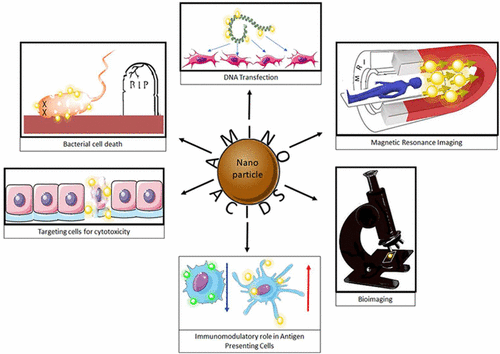当前位置:
X-MOL 学术
›
Bioconjugate Chem.
›
论文详情
Our official English website, www.x-mol.net, welcomes your
feedback! (Note: you will need to create a separate account there.)
Amino Acid Functionalized Inorganic Nanoparticles as Cutting-Edge Therapeutic and Diagnostic Agents
Bioconjugate Chemistry ( IF 4.0 ) Pub Date : 2017-09-26 00:00:00 , DOI: 10.1021/acs.bioconjchem.7b00455 Amlan Chakraborty 1 , Jennifer C. Boer 1 , Cordelia Selomulya , Magdalena Plebanski 1
Bioconjugate Chemistry ( IF 4.0 ) Pub Date : 2017-09-26 00:00:00 , DOI: 10.1021/acs.bioconjchem.7b00455 Amlan Chakraborty 1 , Jennifer C. Boer 1 , Cordelia Selomulya , Magdalena Plebanski 1
Affiliation

|
The field of medical diagnostics and therapeutics is being revolutionized by nanotechnology, from targeted drug delivery to cancer immunotherapy. Inorganic nanoparticles are widely used, albeit problems with agglutination, cytotoxicity, free radical generation, and instability in some biological environments limits their utility. Conjugation of biomolecules such as peptides to the surface of nanoparticles can mitigate such problems, as well as confer specialized theranostic (therapeutic and/or diagnostic) properties, useful across biomedical applications such as vaccines, drug delivery, and in vivo imaging. Coating with amino acids, rather than peptides, offers further a highly cost-effective approach (due to their ease of purification and availability), but is currently an underutilized way to decrease toxicity and enhance stability. Amino acid molecules are small (<200 Da) and have both positive and negative charge groups (zwitterionic) facilitating charge-specific molecule binding. Additionally, amino acids exert by themselves some useful biological functions, with antibacterial and viability enhancing properties (for eukaryotic cells). Overall particle size, nanoparticle core, and the specific amino acid used to functionalize their surface influence their biodistribution, and their effects on host immunity. In this review, we provide for the first time an overview of this emerging field, and identify gaps in knowledge for future research.
中文翻译:

氨基酸功能化的无机纳米粒子作为前沿的治疗和诊断剂
纳米技术正在革新医学诊断和治疗领域,从靶向药物递送到癌症免疫疗法。无机纳米粒子被广泛使用,尽管存在凝集,细胞毒性,自由基生成和某些生物环境中的不稳定性等问题,限制了它们的实用性。诸如肽之类的生物分子与纳米颗粒表面的缀合可以缓解此类问题,并赋予专门的治疗诊断(治疗和/或诊断)特性,可用于生物医学应用,如疫苗,药物递送和体内成像。用氨基酸而不是肽包被提供了进一步的极具成本效益的方法(由于其易于纯化和可利用性),但目前是减少毒性和增强稳定性的未充分利用的方法。氨基酸分子很小(<200 Da),同时具有正电荷基团和负电荷基团(两性离子),有助于电荷特异性分子结合。另外,氨基酸自身发挥一些有用的生物学功能,具有抗菌和增强活力的特性(对于真核细胞)。总体粒径,纳米粒子核心以及用于功能化其表面的特定氨基酸会影响其生物分布及其对宿主免疫力的影响。在这篇评论中,我们首次提供了这一新兴领域的概述,
更新日期:2017-09-26
中文翻译:

氨基酸功能化的无机纳米粒子作为前沿的治疗和诊断剂
纳米技术正在革新医学诊断和治疗领域,从靶向药物递送到癌症免疫疗法。无机纳米粒子被广泛使用,尽管存在凝集,细胞毒性,自由基生成和某些生物环境中的不稳定性等问题,限制了它们的实用性。诸如肽之类的生物分子与纳米颗粒表面的缀合可以缓解此类问题,并赋予专门的治疗诊断(治疗和/或诊断)特性,可用于生物医学应用,如疫苗,药物递送和体内成像。用氨基酸而不是肽包被提供了进一步的极具成本效益的方法(由于其易于纯化和可利用性),但目前是减少毒性和增强稳定性的未充分利用的方法。氨基酸分子很小(<200 Da),同时具有正电荷基团和负电荷基团(两性离子),有助于电荷特异性分子结合。另外,氨基酸自身发挥一些有用的生物学功能,具有抗菌和增强活力的特性(对于真核细胞)。总体粒径,纳米粒子核心以及用于功能化其表面的特定氨基酸会影响其生物分布及其对宿主免疫力的影响。在这篇评论中,我们首次提供了这一新兴领域的概述,











































 京公网安备 11010802027423号
京公网安备 11010802027423号